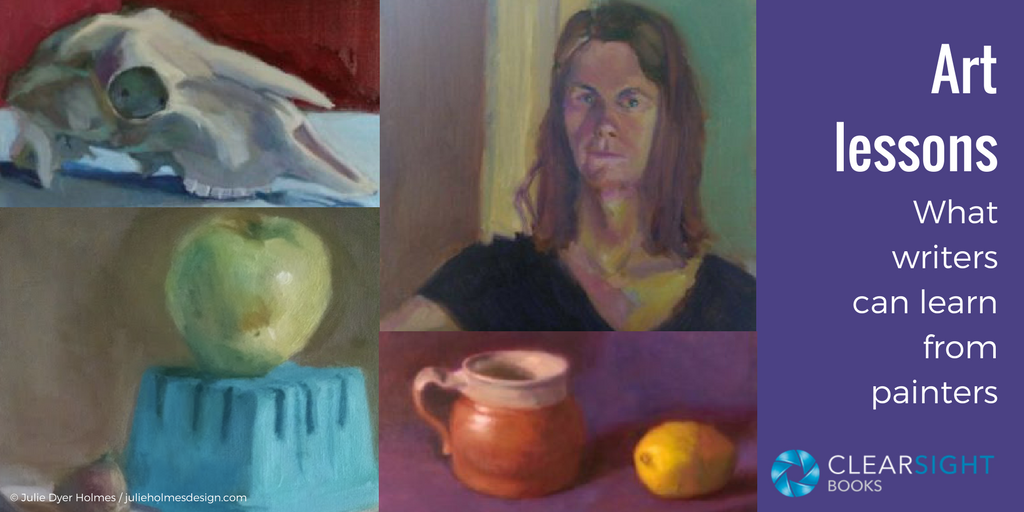
My friend Julie just started her final year of art school. Over the past three years she’s been blogging about her experience, and I’ve enjoyed watching her progress. After a recent touch-base, I started thinking about art—painting especially—and what lessons it can offer writers.
I put my finger on two core principles: practice and release.
Lesson 1: Practice…
In her blog, Julie describes practicing six hours a day, five days a week (and probably more). During the first year, she was allowed to use only charcoal. In the second year she expanded to graphite and oil paint. The foundational skills had to be practiced and solidified before moving on to the next.
…with intention
Practice with the intention to become better at a particular element. Discover the Ahas: What works? Why? You can then choose to apply that technique at the right time and place.
Even during summer breaks, Julie sets herself daily practice: drawing an ear over multiple days, painting an egg every day, painting multiple self-portraits.
…without attachment to outcome
Since the goal is improvement, do not become attached to the outcome. The work does not need to be “finished” or “good.”
Julie writes in one art-school report:
At this stage of learning, I am only spending two 20-minute sessions with each painting. Then we wipe out our work and begin a new pose and painting. This helps me lose the affinity I might be developing for a particular painting…
There is no need to expect an end product here. When you practice, just focus on the process and technique.
Do you practice writing?
When was the last time you practiced—just for the sake of improvement—using metaphor? Or creating snappy dialog? Or writing evocative descriptions without getting flowery?
In my experience, visual artists pursue intentional practice more regularly than writers do. And I include myself in that assessment.
When I write poetry, I often use exercises, or “prompts,” to get me started. But those prompts are just jumping-off points, not intentional areas of focus for improvement. As a result, when a prompt doesn’t result in a good poem for me, it is a “failure.”
Do you see the problem there?
Practice does NOT equal failure! It’s time for me to shift my thinking on this.
What areas of your writing would benefit from intentional practice without regard to outcome? Any adjustment needed in your attitude towards practice?
Lesson 2: Release “good” to find “better”
In practice and with practice, it becomes easier to accept the lack of a finished outcome. But what about when you’re working on a “real” painting or a “real” article? Don’t you want to keep all the good stuff?
As tempting as that is, you must be willing to let go of “good” to create “better.”
Paint over it
As I’ve learned from Julie and other artists, in painting (oil especially) you often layer paint on paint, building up light in one area and dark in another to create the images you want.
If something isn’t working, you paint over it. And, if one element is working but causes the rest of the painting not to work, you paint over it and find something that allows the whole piece to work.
The result of being willing to let go—to paint over something already good—is greater depth and richness and more layers (literally and figuratively).
Translation for writers: “Kill your darlings”
Every writer in the world would love to keep all their beautiful words. But if those beautiful words confuse your reader, or otherwise stand out in some inappropriate way—style mismatch, self-indulgence, excessive cleverness—they’ve got to go.
This is when you have to “kill your darlings,” that is, delete those pretty passages and paint something new.
After so many years of writing, this lesson I have learned fairly well. My red flag is a feeling of resistance. When I find myself trying to rearrange all the other words around my prettiest, most precious words, no matter how awkward things get, I know I’ve found a darling. When the realization hits, I usually sigh and utter a mild swear word. (If I really love the language, I cut and paste it into another document so I don’t lose it—though I can’t remember a single time I’ve gone back to retrieve a darling.)
More often than not, once I’ve removed the precious bit of language, new opportunities appear and I quickly see how to fix whatever wasn’t working.
Do you release words that are no longer serving your work? Try releasing a favorite phrase that’s causing you to struggle. What do you notice, before and after release?
Note to the “non-writers”
Many of my clients and colleagues are writing to get their ideas into the world, not to become great writers. (Of course the two are not mutually exclusive.) The idea of practicing writing may not appeal, because they’d rather practice their speaking or develop new consulting approaches. If that sounds like you, be sure you have a good editor.
The psychology of release still comes into play when working with an editor. Whether you’re writing a blog post, a novel, or a business book, an editor can tell you what’s working and what isn’t. Your editor might suggest letting go of beautiful language or clever structure or a pet concept to make way for something better. Warning: You may feel resistance!
As the author, you always make the final decision. But work with an editor you trust to help you get your ideas into the world as effectively as possible.
I’m curious to see how Julie’s final year of art school unfolds—and I’ll be alert to other lessons that writers can borrow from the visual arts!

